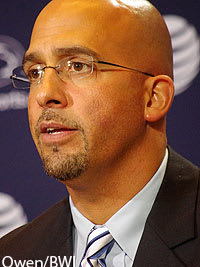Column: Attendance figures reflect future

A press release from Penn State's Sports Information Department on Wednesday morning announced proudly that, once again, the Nittany Lions drew among the top five home crowds in all of college football during the 2013 season.
In fact, for 23 years in a row, the announcement read, Penn State has finished "among the top five nationally in home attendance, according to the NCAA."
Advertisement
With a total of 676,112 fans attending seven games at Beaver Stadium during the 2013 season, the Nittany Lions averaged 96,587 fans per game, a decrease of just 0.1 percent for each contest, according to the university's numbers.
Just two years into the NCAA's draconian sanctions against Penn State's program, the numbers speak to a few things, including the direct impact of the sanctions, the impact of Penn State's ill-timed, ill-fated STEP ticket purchasing program in the midst of an economic downturn , far-reaching trends in game attendance at every level of major athletics, and maybe most interesting, the ability of former Penn State head coach Bill O'Brien to keep fans in seats, and his quest to fill whatever empty ones were left over.
Acknowledging the magnitude of the conversation regarding Penn State's ticketing structures and the variety of factors that all play a role in how many people show up for games at Beaver Stadium, for the sake of Wednesday's news, I'm most interested in O'Brien's role and what it means for James Franklin moving forward.
Specifically, O'Brien's obsession with seeing Beaver Stadium filled with fans each week was palpable both publicly and privately.
According to multiple knowledgable sources, stadium attendance at home games was a source of both frustration and inspiration during O'Brien's two-year tenure at Penn State, and his words and actions - though not always as obvious as a pitch to sell tickets at the end of a press conference or radio show - demonstrated as much.
Knowing the variety of factors already at play, as well as the program's own significant hurdles to remaining relevant competitively through the duration of the sanctions, O'Brien was determined to sell the image - both real and perceived - that Penn State was, is, and will continue to be an elite football program with the excitement, enthusiasm, and fans in the stands to back it up. Understanding the cyclical nature of attendance, recruiting top athletes, and winning (see: Penn State men's basketball), O'Brien understood attendance figures to be less an indication of the program's current health, but rather, a tool to ensure future prosperity.
Additionally, understanding Penn State's financial pinch in the athletic department following a $60 million fine against the program from the NCAA and countless more millions withheld by the Big Ten from shared bowl revenue (original estimates were at $13 million over four years, but renegotiated contracts have actually shoved that number considerably higher), O'Brien pushed strenuously via the Coaches Caravan and other public appearances for both big time donations as well as attendance at games.
O'Brien was also pushing equally hard behind the scenes.
Generating multiple ideas for increasing home game attendance - including the possibility of his own personal donations used to allocate free or heavily discounted tickets to both students and townspeople - O'Brien appeared at times to be obsessed with preventing the sharp decline in attendance numbers that had originally been predicted for the program in the initial aftermath of the NCAA's sanctions. In dealing with multiple university entities including the Nittany Lion Club and Penn State athletics, though, the existing structure of Beaver Stadium's seating plans effectively prevented many of O'Brien's proposed initiatives from ever getting off the ground.
Succeeded by Franklin, a coach blessed with a zeal for making public statements and an enthusiasm befitting of the program's current needs, the future of Penn State's attendance numbers will be fascinating to watch - not least of all because of Franklin's introductory press conference announcing his expectations for a full stadium.
"There is tremendous pride and passion in Penn State and the football program," he said. "The great crowds, sold out crowds, and atmosphere in Beaver Stadium have a tremendous impact on the team and on recruits. It is a world-class facility, a large part of Penn State's unrivaled football tradition, and we can't wait to see 107,000 strong at the Blue-White Game and every game next season."
Regardless of the passion and enthusiasm O'Brien's teams seemed to generate in 2012 and '13 - aided in no small way by the likes of Michael Mauti, Matt McGloin, Christian Hackenberg and Allen Robinson, to be sure - there's little doubt that Franklin's hiring and first impression have further invigorated the program.
Sharply contrasting with O'Brien's somewhat brash demeanor and clear personal level of discomfort engaging with fans and boosters, Franklin's efforts to increase attendance at games - though likely similar - appear to be in his wheelhouse instead of being so clearly out of character.
Whether or not O'Brien's or Franklin's efforts can overcome some of the outside factors at play remains to be seen, but quite clearly, both understood and will emphasize the importance of attendance for the program's health moving forward.